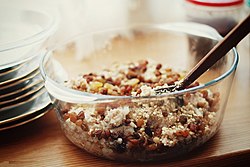Kutia
 | |
| Associated cuisine | Ukrainian, Belarusian, Russian |
|---|---|
| Main ingredients | Wheatberries, poppy seeds, honey or sugar, various nuts and sometimes raisins |
Kutia or kutya is a ceremonial grain dish with sweet gravy traditionally served by Eastern Orthodox Christians in Ukraine, Belarus and Russia during the Christmas - Feast of Jordan holiday season and/or as part of a funeral feast. The word with a descriptor is also used to describe the eves of Christmas, New Year, and Feast of Jordan days.[1][2][3]
Etymology
The word kutia is a borrowing from the Greek language κουκκί (bean) or κόκκος (grain).[4]
Description
Ukraine
In Ukraine kutia is an essential dish at the Ukrainian Christmas Eve Supper[5] (also known as Sviata vecheria or Svyata vecherya). It is believed that kutia has been known to Ukrainians’ ancestors since pre-historic times.[6]
The main ingredients used to make traditional kutia are: wheatberries, poppy seeds and honey.[7] At times, walnuts, dried fruit and raisins are added as well. Kutia is a Lenten dish and no milk or egg products can be used. There are known kutia recipes that use pearl barley instead of wheatberries.[8]
Kutia, as a part of Ukrainian Christmas Eve Supper, is used in a number of rituals performed on the night. Kutia is the first out of twelve dishes served for Sviata Vecheria to be tasted.[9] Everyone present must have at least a spoonful of kutia.[10] In the past, the head of the household used kutia to foretell whether the upcoming year harvest would be plentiful; and to bargain with the forces of the nature asking for good weather.[11]
Kolyvo is a Ukrainian ritual dish similar to kutia, but includes no poppy seeds. Kolyvo is served at remembrance services.
Other countries
A dish of boiled grains (usually wheat berries) mixed with honey, nuts, spices, and a few other ingredients is traditional in other countries[12] as well:
- Bulgaria – kolivo
- Greece – koliva
- Lebanon, Palestine and Jordan – ameh masslouk or snuniye
- Romania – colivă
- Russia – sochivo
- Serbia – koljivo
- Sicily – cuccìa
- Syria – sliha or burbara (for Eid il-Bur-bara, St. Barbara's Feast throughout the Middle East)
See also
References
- ^ Білодід, Iван (ed.). "Кутя". Словник української мови в 11 томах (in Ukrainian). Київ: Наукова думка.
- ^ Даль, Владимир (1905). Кутия (in Russian). Санкт-Петербург-Москва: Товарищества М.О. Вольф.
{{cite book}}:|work=ignored (help) - ^ Крапіва, K, ed. (1977–1984). Куцця (in Belarusian). Менск: Беларуская Савецкая Энцыклапедыя.
{{cite book}}:|work=ignored (help) - ^ Мельничук, О, ed. (1989). Кутя (PDF) (in Ukrainian). Vol. 3. Київ: Наукова думка.
{{cite book}}:|work=ignored (help) - ^ Recipe: Kutia, Star of the Ukrainian Christmas Eve Supper
- ^ Tracz, Orysia 2015, First Star I See Tonight, Mazepa Publications Zhuravli, Winnipeg
- ^ Artiukh, Lidia 2001, Ukrainian Cuisine and Folk Traditions, Baltija-Druk, Kyiv
- ^ Yakovenko, Svitlana 2016, Ukrainian Christmas Eve Supper: Traditional village recipes for Sviata Vecheria, Sova Books, Sydney
- ^ Stechishin, Savella 1959, Traditional Ukrainian Cookery, Trident Press, Winnipeg
- ^ Yakovenko, Svitlana 2013, Taste of Ukraine: Rustic Cuisine from the heart of Ukraine, Sova Books, Sydney
- ^ Voropai, Oleksa 1958, Zvychai Nashoho Narodu [Customs of Our People], Ukrainske Vydavnytstvo, Munich
- ^ Goldstein, Darra 2015, The Oxford Companion to Sugar and Sweets, Oxford University Press, Oxford
